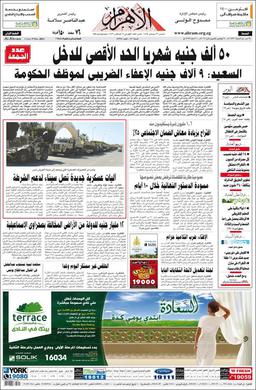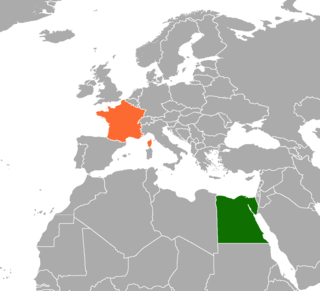
Gamal Abdel Nasser Hussein was an Egyptian military officer and politician who served as the second president of Egypt from 1954 until his death in 1970. Nasser led the Egyptian revolution of 1952 and introduced far-reaching land reforms the following year. Following a 1954 attempt on his life by a Muslim Brotherhood member, he cracked down on the organization, put President Mohamed Naguib under house arrest and assumed executive office. He was formally elected president in June 1956.
According to most scholars the history of modern Egypt dates from the start of the rule of Muhammad Ali'v in 1805 and his launching of Egypt's modernization project that involved building a new army and suggesting a new map for the country, though the definition of Egypt's modern history has varied in accordance with different definitions of modernity. Some scholars date it as far back as 1516 with the Ottomans' defeat of the Mamlūks in 1516–17.

Al-Ahram, founded on 5 August 1875, is the most widely circulating Egyptian daily newspaper, and the second oldest after al-Waqa'i`al-Masriya. It is majority owned by the Egyptian government, and is considered a newspaper of record for Egypt.

Mohamed Hassanein Heikal was an Egyptian journalist. For 17 years (1957–1974), he was editor-in-chief of the Cairo newspaper Al-Ahram and was a commentator on Arab affairs for more than 50 years.

The National Democratic Party, often referred to in Egypt as simply the National Party, was the ruling political party in Egypt from 1978 to 2011. The party was founded by former President Anwar Sadat in 1978.
Hamdi Qandil was a prominent Egyptian journalist, news anchor, talk show host and activist. Qandil started his journalism career in the 1950s when he wrote for the Akher Sa'a magazine at the invitation of veteran journalist Mustafa Amin. In 1961 he began broadcasting a news show called Aqwal al-Suhuf until 1969 when he was appointed director of the Arab Broadcasting Studios Union. In 1971 he left his post in protest at a government inspection of his technical staff. He later worked with UNESCO from 1974 to 1986, specializing in the field of international media. In 1987 he co-founded a satellite broadcasting company that later became known as MBC, where he worked for three months before leaving because of political differences with its management. Qandil briefly presented the show Ma'a Hamdi Qandil for ART, but left amid disagreements between him and his managers regarding Qandil's planned interviews with Muammar Gaddafi and Tariq Aziz.

Egypt–Russia relations are the bilateral relations between Egypt and Russia. Diplomatic relations between the Soviet Union and Egypt were established on August 26, 1943. Egypt has an embassy in Moscow, while Russia has an embassy in Cairo and a consulate-general in Alexandria.

The Egyptian Radio and Television Union is the public broadcaster of Egypt, operated by the Egyptian government. It is a member of the European Broadcasting Union.
Rose al-Yūsuf is an Arabic weekly political magazine published in Egypt.

Khaled Mohieddine was an Egyptian revolutionary, politician, and military officer. As a member of the Free Officers Movement, he participated in the toppling of King Farouk that began the Egyptian Revolution of 1952, and led to the establishment of the Republic of Egypt.

Egypt–France relations, also known as Egyptian–French relations, are the bilateral relations between Egypt and France. Relations between the two countries have spanned centuries, from the Middle Ages to the present day. Following the French occupation of Egypt (1798-1801), a strong French presence has remained in Egypt. Egyptian influence is also evident in France, in monuments such as the Luxor Obelisk in Paris. The relationship is also marked by conflicts like the Algerian War (1954-1962) and the Suez Crisis (1956). As of 2020, relations are strong and consist of shared cultural activities such as the France-Egypt Cultural Year (2019), tourism, diplomatic missions, trade, and a close political relationship. Institutions like the Institut d’Égypte, the French Institute in Egypt and the French University of Egypt (UFE) also aid in promoting cultural exchange between Egypt and France.

The 2011 Egyptian revolution, also known as the 25 January revolution, began on 25 January 2011 and spread across Egypt. The date was set by various youth groups to coincide with the annual Egyptian "Police holiday" as a statement against increasing police brutality during the last few years of Hosni Mubarak's presidency. It consisted of demonstrations, marches, occupations of plazas, non-violent civil resistance, acts of civil disobedience and strikes. Millions of protesters from a range of socio-economic and religious backgrounds demanded the overthrow of Egyptian President Hosni Mubarak. Violent clashes between security forces and protesters resulted in at least 846 people killed and over 6,000 injured. Protesters retaliated by burning over 90 police stations across the country.

Egypt–Palestine relations are the bilateral relations between the Arab Republic of Egypt and the State of Palestine. Egyptian President Gamal Abdel Nasser was a strong supporter of the Palestinian cause and he favored self-determination for the Palestinians. Although the Egyptian government has maintained a good relationship with Israel since the Camp David Accords, most Egyptians strongly resent Israel, and disapprove of the close relationship between the Israeli and Egyptian governments.

Hamdeen Sabahi is an Egyptian politician, journalist. He is currently the leader of the Egyptian Popular Current and a co-leader of the National Salvation Front. An opposition activist during the Anwar Sadat and Hosni Mubarak eras, Sabahi was jailed 17 times during their presidencies for political dissidence. He was an immediate supporter and participant of the 2011 Egyptian revolution. Sabahi entered the 2012 Egyptian presidential race in which he finished third place with 21.5% of the vote trailing the second place candidate Ahmed Shafiq by a margin of 700,000 votes. In the 2014 presidential election he was one of just two candidates. He ran second with less than 4% of the vote. Abdel Fattah el-Sisi was declared the winner after attracting 22 million of the nearly 23 million votes cast. Sisi was sworn into office as President of Egypt on 8 June 2014.
Contemporary art in Egypt is a term used to refer to visual art, including installations, videos, paintings, or sculptures, developed in the Egyptian art scene. While the contemporary art scene is mainly concentrated in Cairo and Alexandria, it is developing fast with the emergence of spaces for artists, and support from the public or from abroad. Many Egyptian artists use the Egyptian contemporary art scene as a ramp toward the international art scenes.
Al Ahrar was a weekly newspaper published in Cairo, Egypt, from 1977 to 2013. The paper was the official media outlet of the Liberal Party.
The Syrian coup d'état of 1961 was an uprising by disgruntled Syrian Army officers on 28 September 1961, that resulted in the break-up of the United Arab Republic and the restoration of an independent Syrian Republic.
There were multiple newspapers published in the Ottoman Empire.
Al Ustadh was an Arabic satirical, literary and political journal that was established by Abdullah Al Nadim in Cairo, Egypt, and published for eleven months in the period August 1892–June 1893. Although it was a short-lived publication, it played an important role in the development of short story genre in Arabic.













